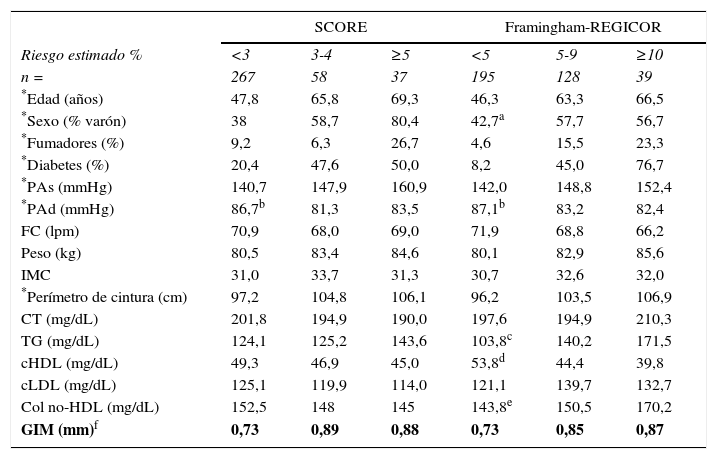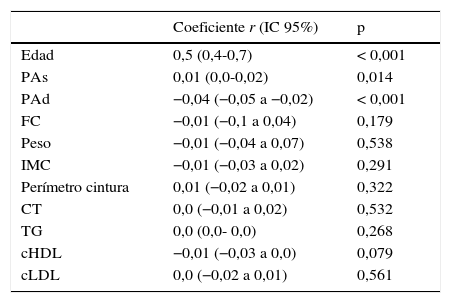El grosor íntima-media carotídeo (GIMc) ha sido propuesto como complemento a las escalas de cálculo del riesgo cardiovascular (RCV). El objetivo del presente estudio es describir la asociación entre el GIMc y el grado de RCV estimado según las funciones SCORE y Framingham-REGICOR.
MétodoEstudio observacional, transversal de una cohorte de 362 pacientes hipertensos. Se les realizó de forma sistemática una evaluación clínico-epidemiológica, analítica, ultrasonográfica y una estimación del RCV según las tablas SCORE y Framingham-REGICOR. Mediante el software SPSS (versión 20,0), se llevó a cabo el análisis de datos utilizando los análisis estadísticos t de Student, chi-cuadrado, coeficiente de Pearson y el análisis de la varianza (ANOVA).
ResultadosSe demuestran diferencias significativas en la media de GIMc entre los pacientes con RCV estimado bajo (GIMc: 0,73mm en ambas funciones) y los de riesgo moderado (GIMc: 0,89 y 0,85mm según SCORE y Framingham-REGICOR) o elevado (0,88 y 0,87mm respectivamente). No existen diferencias entre los de riesgo moderado y elevado.
El GIMc se correlaciona positivamente con el valor de RCV estimado mediante las tablas SCORE (r=0,421; p<0,01), así como con la función Framingham-REGICOR (r=0,363; p<0,01).
ConclusionesEl GIMc se correlaciona positivamente con el grado de RCV estimado mediante las funciones SCORE y Framingham-REGICOR. Aquellos pacientes con riesgo moderado presentan un GIMc similar al de aquellos con riesgo elevado. Se destaca la utilidad del estudio ultrasonográfico carotídeo para la detección precoz de lesión silente en pacientes con RCV moderado.
Carotid intima-media thickness (cIMT) has been suggested as a further tool for risk function charts. The aim of this study was to describethe relationship between cIMT and cardiovascular risk (CVR) estimation according to Framingham-REGICOR and SCORE equations.
MethodsObservational, cross-sectional cohort study from 362 hypertensive subjects. Demographic and clinical information were collected as well as laboratory, ultrasonographic and CVR estimation by the Framingham-REGICOR and SCORE functions. Statistical analysis was performed using SPSS software (version 20,0). To analyze the data, statistical tests such as Chi-square, T-test, ANOVA, and Pearson correlation coefficient were used.
ResultsAccording to both functions, differences on mean cIMT were found between low CVR group and intermediate to high groups. No differences were found between intermediate and high risk groups (cIMT: 0,73mm low risk patients vs. 0,89 or 0,88mm respectively according to SCORE function and cIMT: 0,73 vs. 0,85 or 0,87mm respectively according to Framingham-REGICOR function).
cIMT correlated positively with CVR estimation according to both SCORE (r=0,421; P<.01), and Framingham-REGICOR functions (r=0,363; P<.01).
ConclusionscIMT correlates positively with CVR estimated by SCORE and Framingham-REGICOR functions. cIMT in those subjects at intermediate risk is similar to those at high risk. Our findings highlight the importance of carotid ultrasound in identifying silent target-organ damage in those patients at intermediate CVR.
Artículo
Comprando el artículo el PDF del mismo podrá ser descargado
Precio 19,34 €
Comprar ahora








